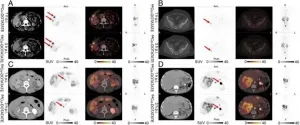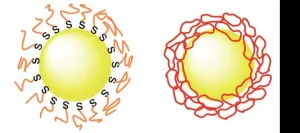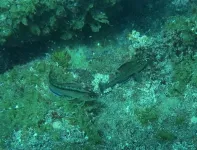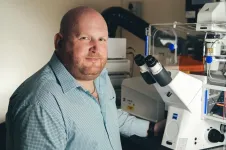(Press-News.org) Reston, Virginia--The imaging time window of 64Cu-DOTATATE positron emission tomography/computed tomography (PET/CT) for patients with neuroendocrine neoplasms can be expanded from one hour to three hours post-injection, according to new research published in the January issue of the Journal of Nuclear Medicine. In a head-to-head comparison of scans performed at the two time intervals, there were no significant differences in the number of lesions detected, and tumor-to-normal tissue ratios remained high in all key organs.
Previous research has demonstrated that 64Cu-DOTATATE PET imaging at one hour post-injection provides excellent lesion detection in patients with neuroendocrine neoplasms. "Given the long half-life and excellent image resolution of 64Cu-DOTATATE, we sought to investigate if the imaging time window for 64Cu-DOTATATE PET could be expanded from one hour to up to three hours without a loss in the ability to detect lesions," said Andreas Kjaer, MD, PhD, DMSc, professor at University of Copenhagen and chief physician at Rigshospitalet, the National University Hospital of Denmark, both in Copenhagen, Denmark.
In the prospective study, 35 patients with neuroendocrine neoplasms received 64Cu-DOTATATE whole-body PET imaging at both one hour post-injection and three hours post-injection. The number of lesions on the scans were counted and grouped according to organs or regions and were then compared. Uptake of 64Cu-DOTATATE in lesions and normal tissues was measured, and tumor-to-normal tissue ratios were calculated.
A total of 882 concordant lesions (visible on both the one-hour and three-hour post-injection 64Cu-DOTATATE PET) were found. Five discordant lesions, which were found on one of the PET scans but not the other, were noted; however, only four were considered true based on further imaging. Throughout the one to three hour post-injection imaging window, the tumor-to-normal tissue ratios were high in all key organs, including the liver, intestines, pancreas and bone.
"The high agreement in the number of lesions detected on both the one-hour and three-hour post-injection 64Cu-DOTATATE PET supports the rationale of expanding the imaging time window," stated Kjaer. "Since 64Cu-DOTATATE has a shelf-life of 24 hours, which is much longer than other PET imaging options, it offers greater convenience and flexibility for routine imaging of patients with neuroendocrine neoplasms. We expect to see more 64Cu-labeled PET tracers for routine use in the future."
Neuroendocrine neoplasms represent a heterogeneous class of diseases with large variability in aggressiveness and prognosis. These rare tumors most frequently originate from the pancreas, the gastrointestinal tract or the lung. Approximately 12,000 Americans are diagnosed with neuroendocrine neoplasms each year.
INFORMATION:
This study was made available online in May 2020 ahead of final publication in print in January 2021.
The authors of "64Cu-DOTATATE PET in Patients with Neuroendocrine Neoplasms: Prospective, Head-to-Head Comparison of Imaging at 1 Hour and 3 Hours Post-Injection," include Mathias Loft, Esben A. Carlsen, Camilla B. Johnbeck, Helle H. Johannesen, Tina Binderup, Andreas Pfeifer, Jann Mortensen, Peter Oturai, Annika Loft, Anne K. Berthelsen and Andreas Kjaer, Department of Clinical Physiology, Nuclear Medicine & PET and Cluster for Molecular Imaging, Rigshospitalet and University of Copenhagen, Denmark; Seppo W. Langer, Department of Oncology, Rigshospitalet, Copenhagen, Denmark, and Ulrich Knigge, Departments of Clinical Endocrinology and Surgical Gastroenterology, Rigshospitalet, Copenhagen, Denmark. All departments are part of ENETS Neuroendocrine Tumor Center of Excellence, Rigshospitalet, Copenhagen, Denmark.
Please visit the SNMMI Media Center for more information about molecular imaging and precision imaging. To schedule an interview with the researchers, please contact Rebecca Maxey at (703) 652-6772 or rmaxey@snmmi.org.
About the Society of Nuclear Medicine and Molecular Imaging
The Journal of Nuclear Medicine (JNM) is the world's leading nuclear medicine, molecular imaging and theranostics journal, accessed close to 10 million times each year by practitioners around the globe, providing them with the information they need to advance this rapidly expanding field. Current and past issues of the Journal of Nuclear Medicine can be found online at http://jnm.snmjournals.org.
JNM is published by the Society of Nuclear Medicine and Molecular Imaging (SNMMI), an international scientific and medical organization dedicated to advancing nuclear medicine and molecular imaging--precision medicine that allows diagnosis and treatment to be tailored to individual patients in order to achieve the best possible outcomes. For more information, visit http://www.snmmi.org.
Successful weight loss is considered to be an integral part of the therapy for type 2 diabetes. Nevertheless, studies keep appearing that question the importance of losing weight. However, new data from a large-scale observational study carried out at DIfE in cooperation with the German Center for Diabetes Research (DZD) support the current recommendations of physicians. The findings, published in the journal Diabetologia, suggest that obesity and weight gain can lead to vascular disorders, the leading cause of disease and death for people with type 2 diabetes.
A close look at vascular disorders
Weight plays a crucial role in the development of type 2 diabetes. However, ...
Chemical engineers at UNSW Sydney have found a way to make 'green' ammonia from air, water and renewable electricity that does not require the high temperatures, high pressure and huge infrastructure currently needed to produce this essential compound.
And the new production method - demonstrated in a laboratory-based proof of concept - also has the potential to play a role in the global transition towards a hydrogen economy, where ammonia is increasingly seen as a solution to the problem of storing and transporting hydrogen energy.
In a paper published today in Energy and Environmental Science, the authors from UNSW and University of Sydney say that ammonia synthesis was one of the critical achievements of the 20th century. When used in fertilisers ...
It takes a lot to make a wooden table. Grow a tree, cut it down, transport it, mill it ... you get the point. It's a decades-long process. Luis Fernando Velásquez-García suggests a simpler solution: "If you want a table, then you should just grow a table."
Researchers in Velásquez-García's group have proposed a way to grow certain plant tissues, such as wood and fiber, in a lab. Still in its early stages, the idea is akin in some ways to cultured meat -- an opportunity to streamline the production of biomaterials. The team demonstrated the concept by growing structures made of wood-like cells from an initial sample of cells extracted from zinnia leaves.
While that's still ...
Hokkaido University scientists have found a way to prevent gold nanoparticles from clumping, which could help towards their use as an anti-cancer therapy.
Attaching ring-shaped synthetic compounds to gold nanoparticles helps them retain their essential light-absorbing properties, Hokkaido University researchers report in the journal Nature Communications.
Metal nanoparticles have unique light-absorbing properties, making them interesting for a wide range of optical, electronic and biomedical applications. For example, if delivered to a tumour, they could react with applied light to kill cancerous tissue. A problem with this approach, though, is that they easily clump together in solution, losing their ability to absorb light. ...
Thirty-five people have died in the custody of U.S. Immigration and Customs Enforcement (ICE) since April 2018, with a seven-fold increase in deaths even as the average daily population decreased by nearly a third between 2019 and 2020, a new USC study shows.
"Potentially preventable causes of death -- including COVID-19 infection, influenza and suicide -- are responsible for at least half of recent deaths," said researcher Sophie Terp, an assistant professor of clinical emergency medicine at the Keck School of Medicine of USC and a clinical scholar at the USC Schaeffer Center for Health Policy and ...
Research from the University of Adelaide has found that some species of fish will have higher reproductive capacity because of larger sex organs, under the more acidic oceans of the future.
Published in PLOS Biology, the researchers say that far from the negative effects expected under the elevated CO2 levels in our oceans predicted for the end of the century, these fish capitalise on changes to the underwater ecosystems to produce more sperm and eggs. They also look after them better, enhancing the chances of reproductive success.
"The warming oceans absorb about one-third of the additional CO2 being released into the atmosphere from carbon emissions, causing the oceans to acidify," says lead author Professor Ivan Nagelkerken from the University's Environment ...
Dendritic cells are a vital component of the innate immune system, which constitutes the body's first line of defense against infectious agents and tumor cells. Their job is to activate the T-cell arm of the adaptive immune system, which confers specific and long-lasting protection against bacterial and viral infections. Dendritic cells engulf and degrade proteins that signal the presence of invasive pathogens. The resulting fragments (antigens) are displayed on their surfaces. T cells bearing the appropriate receptors are then activated to seek out and eliminate the pathogen. Newborns and young children ...
Packing a lunchbox with fruit, sandwiches, and snacks is common practice for most Australian families. But what if there was another way?
Flinders University researchers investigating the pros and cons of school-provided lunches say uniform delivery of lunchtime food at school could be a solution to better childhood nutrition and learning in Australia.
Flinders Caring Futures Institute deputy director Professor Rebecca Golley says universal school-provided lunch models - a common practice in other countries such as the UK - would involve all children in the ...
Scientists have for the first time established a sensory neuron model able to mass-reproduce two key sensory neuron types involved in pain sensation, enabling the easy generation of large numbers of the cells to fast-track chronic pain research.
In research applications usually sensory neurons need to be isolated from animals. They represent a wide variety of different cell types, making it difficult to collect and isolate large quantities of pain sensing neurons.
Using a new technique, researchers at Flinders University have found a way to reproduce millions of the cells, providing ample resources for the simultaneous testing of thousands of samples or potential drug libraries.
"Our ...
Education, professional skills and experience are the essential criteria for filling a position - or at least that is the expectation. The reality often looks different, as numerous studies have shown. When deciding whether to hire a candidate or not, gender, origin or ethnicity sometimes also play an important role; factors that say little about a candidate's suitability for a job.
This type of discrimination violates the principle of equal opportunities. For those affected, this may have long-term disadvantages, such as longer unemployment or lower wages. This is why it is crucial to understand who is discriminated against, and why. The study conducted by Dominik Hangartner (Public Policy Group), Daniel Kopp and Michael Siegenthaler (both KOF Swiss Economic Institute) ...





